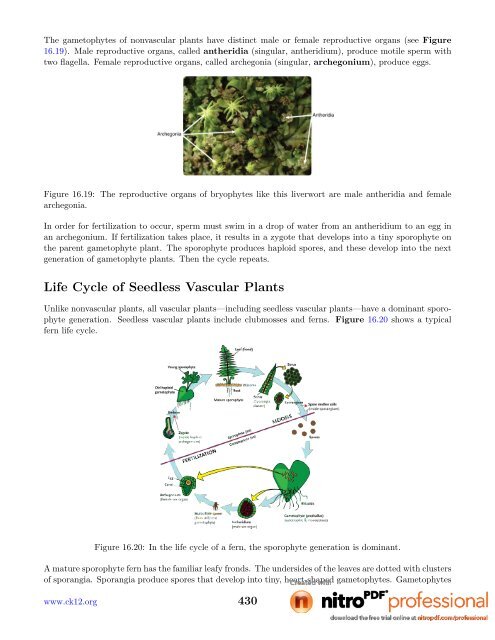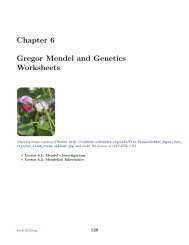Life Cycle of Seedless Vascular Plants - Wikispaces
Life Cycle of Seedless Vascular Plants - Wikispaces
Life Cycle of Seedless Vascular Plants - Wikispaces
Create successful ePaper yourself
Turn your PDF publications into a flip-book with our unique Google optimized e-Paper software.
not need adaptations for absorbing, transporting, and conserving water. They can save energy and matterby not growing extensive root systems, vascular tissues, or thick cuticles on leaves. Support is also less <strong>of</strong>a problem because <strong>of</strong> the buoyancy <strong>of</strong> water. As a result, adaptations such as strong woody stems anddeep anchoring roots are not necessary for most aquatic plants.Living in water does present challenges to plants, however. For one thing, pollination by wind or animalsisn’t feasible under water, so aquatic plants may have adaptations that help them keep their flowers abovewater. For instance, water lilies have bowl-shaped flowers and broad, flat leaves that float. This allows thelilies to collect the maximum amount <strong>of</strong> sunlight, which does not penetrate very deeply below the surface.<strong>Plants</strong> that live in moving water, such as streams and rivers, may have different adaptations. For example,cattails have narrow, strap-like leaves that reduce their resistance to the moving water (see Figure 16.23).Figure 16.23: Water lilies and cattails have different adaptations for life in the water. Compare the leaves<strong>of</strong> the two kinds <strong>of</strong> plants. How do the leaves help the plants adapt to their watery habitats?Adaptations to Extreme Dryness<strong>Plants</strong> that live in extremely dry environments have the opposite problem: how to get and keep water.<strong>Plants</strong> that are adapted to very dry environments are called xerophytes. Their adaptations may helpthem increase water intake, decrease water loss, or store water when it is available.The saguaro cactus pictured in Figure 16.24 has adapted in all three ways. When it was still a very smallplant, just a few inches high, its shallow roots already reached out as much as 2 meters (7 feet) from thebase <strong>of</strong> the stem. By now, its root system is much more widespread. It allows the cactus to gather as muchmoisture as possible from rare rainfalls. The saguaro doesn’t have any leaves to lose water by transpiration.It also has a large, barrel-shaped stem that can store a lot <strong>of</strong> water. Thorns protect the stem from thirstyanimals that might try to get at the water inside.Adaptations to Air<strong>Plants</strong> called epiphytes grow on other plants. They obtain moisture from the air and make food byphotosynthesis. Most epiphytes are ferns or orchids that live in tropical or temperate rainforests (seeFigure 16.25). Host trees provide support, allowing epiphyte plants to obtain air and sunlight high abovethe forest floor. Being elevated above the ground lets epiphytes get out <strong>of</strong> the shadows on the forest floorso they can get enough sunlight for photosynthesis. Being elevated may also reduce the risk <strong>of</strong> being eatenby herbivores and increase the chance <strong>of</strong> pollination by wind.Epiphytes don’t grow in soil, so they may not have roots. However, they still need water for photosynthesis.Rainforests are humid, so the plants may be able to absorb the water they need from the air. However,www.ck12.org 434
Figure 16.24: The saguaro cactus has many adaptations for extreme dryness. How does it store water?Figure 16.25: This elkhorn fern is growing on a rainforest tree as an epiphyte.435 www.ck12.org
many epiphytes have evolved modified leaves or other structures for collecting rainwater, fog, or dew. Theleaves <strong>of</strong> the bromeliad shown in Figure 16.26 are rolled into funnel shapes to collect rainwater. Thebase <strong>of</strong> the leaves forms a tank that can hold more than 8 liters (2 gallons) <strong>of</strong> water. Some insects andamphibians may spend their whole life cycle in the pool <strong>of</strong> water in the tank, adding minerals to the waterwith their wastes. The tissues at the base <strong>of</strong> the leaf are absorbent, so they can take in both water andminerals from the tank.Figure 16.26: The leaves <strong>of</strong> this bromeliad are specialized to collect, store, and absorb rainwater.Plant ResponsesLike all organisms, plants detect and respond to stimuli in their environment. Unlike animals, plants can’trun, fly, or swim toward food or away from danger. They are usually rooted to the soil. Instead, a plant’sprimary means <strong>of</strong> response is to change how it is growing. <strong>Plants</strong> also don’t have a nervous system tocontrol their responses. Instead, their responses are generally controlled by hormones, which are chemicalmessenger molecules.Plant TropismsAs you read earlier in this chapter, plant roots always grow downward because specialized cells in rootcaps detect and respond to gravity. This is an example <strong>of</strong> a tropism. A tropism is a turning toward oraway from a stimulus in the environment. Growing toward gravity is called geotropism. <strong>Plants</strong> also exhibitphototropism, or growing toward a light source. This response is controlled by a plant growth hormonecalled auxin. As shown in Figure 16.27, auxin stimulates cells on the dark side <strong>of</strong> a plant to grow longer.This causes the plant to bend toward the light.www.ck12.org 436
Figure 16.27: Phototropism is controlled by the growth hormone auxin.Daily and Seasonal Responses<strong>Plants</strong> also detect and respond to the daily cycle <strong>of</strong> light and darkness. For example, some plants opentheir leaves during the day to collect sunlight and then close their leaves at night to prevent water loss.Environmental stimuli that indicate changing seasons trigger other responses. Many plants respond to thedays growing shorter in the fall by going dormant. They suspend growth and development in order tosurvive the extreme cold and dryness <strong>of</strong> winter. Dormancy ensures that seeds will germinate and plantswill grow only when conditions are favorable.Responses to Disease<strong>Plants</strong> don’t have immune systems, but they do respond to disease. Typically, their first line <strong>of</strong> defenseis the death <strong>of</strong> cells surrounding infected tissue. This prevents the infection from spreading. Many plantsalso produce hormones and toxins to fight pathogens. For example, willow trees produce salicylic acidto kill bacteria. The same compound is used in many acne products for the same reason. Exciting newresearch suggests that plants may even produce chemicals that warn other plants <strong>of</strong> threats to their health,allowing the plants to prepare for their own defense. As these and other responses show, plants may berooted in place, but they are far from helpless.KQED: Plant Plague: Sudden Oak DeathDevastating over one million oak trees across Northern California in the past ten years, Sudden OakDeath is a killer with no cure. But biologists now are looking to the trees’ genetics for a solution. Seehttp://www.kqed.org/quest/television/plant-plague-sudden-oak-death for more information.Lesson Summary• <strong>Plants</strong> live just about everywhere on Earth, so they have evolved adaptations that allow them tosurvive and reproduce under a diversity <strong>of</strong> conditions. Various plants have evolved adaptations tolive in the water, in very dry environments, or in the air as epiphytes.• Like all organisms, plants detect and respond to stimuli in their environment. Their main responseis to change how they grow. Their responses are controlled by hormones. Some plant responses are437 www.ck12.org
tropisms. <strong>Plants</strong> also respond to daily and seasonal cycles and to disease.Lesson Review QuestionsRecall1. List special challenges that aquatic plants face.2. What are xerophytes? Give an example.3. Identify three general ways that plants can adapt to extreme dryness.4. Describe how epiphytes can absorb moisture without growing roots in soil.5. What is the primary way that plants respond to environmental stimuli? What controls their responses?6. Define tropism. Name one example in plants.7. State ways that plants respond to disease.Apply Concepts8. Apply the concept <strong>of</strong> symbiosis to epiphytes and their host plants. Do you think they have a symbioticrelationship? If so, which type <strong>of</strong> symbiotic relationship do you think they have? Explain your answer.Think Critically9. Why are epiphytes found mainly in rainforest ecosystems?10. Why is it adaptive for plants to detect and respond to daily and seasonal changes?EOL Research11. Bromeliads are some <strong>of</strong> the most common epiphytes. Research bromeliads at EOL and discuss theevolution <strong>of</strong> these species. See the Communities and Populations chapter for information about EOL.Points to ConsiderIn this chapter you read about the cells, tissues, and organs that make up plants. You also read aboutplant life cycles. Like plants, animals are complex organisms with tissues and organs. Animals also havelife cycles.• How do the cells <strong>of</strong> animals differ from those <strong>of</strong> plants? What tissues and organs might be found inanimals?• What is the general animal life cycle? How does it differ from the general life cycle <strong>of</strong> plants?Image Sources(1) Mangrove: Cesar Paes Barreto; Bloodroot: William Curtis. [Mangrove:http://commons.wikimedia.org/wiki/File:Roots_by_cesarpb.jpg; Bloodroot: http:www.ck12.org 438
commons.wikimedia.org/wiki/File:Bloodwort_-_Project_Gutenberg_eText_19123.jpg ].Mangrove: CC-BY-SA; Bloodroot: Public Domain.(2) Moss image copyright JFunk, 2010; fern image copyright Lee Prince, 2010; pine tree image copyrightIgor Sokolov (breeze), 2010; apple tree image copyright Wildheart. http://www.shutterstock.com.All images used under licenses from Shutterstock.com.(3) Taproot: Rasbak; Fibrous: Tobias Geberth. [Taproot:http://commons.wikimedia.org/wiki/File:Paardenbloem_%28Taraxacum_<strong>of</strong>ficinale%29.jpg;Fibrous: http://commons.wikimedia.org/wiki/File:Grass.jpg ]. Taproot: GNU-FDL; Fibrous:CC-BY-SA 2.5.(4) Fir0002/Flagstaffoto, modified by CK-12 Foundation.http://commons.wikimedia.org/wiki/File:Celery_cross_section.jpg. GNU-FDL 1.2.(5) CK-12 Foundation. . CC-BY-NC-SA 3.0.(6) Courtesy <strong>of</strong> kirsbrat, modified by CK-12 Foundation.http://i694.photobucket.com/albums/vv304/kirsbrat/plantcell.png. Public Domain.(7) Top: Cehagenmerak; Bottom: JoJan; modified by CK-12 Foundation. [Top:http://commons.wikimedia.org/wiki/File:Racine3.jpg; Bottom:http://commons.wikimedia.org/wiki/File:Root%28cross_section%29.jpg ]. Top: GNU-FDL1.2; Bottom: GNU-FDL 1.2..(8) Nova and MesserWoland.http://commons.wikimedia.org/wiki/File:Kszta%C5%82ty_li%C5%9Bci2.svg;http://commons.wikimedia.org/wiki/File:Li%C5%9Bcie_z%C5%82o%C5%BCone.png. GNU-FDL1.2.(9) Image copyright Smit, 2010. http://www.shutterstock.com. Used under license fromShutterstock.com.(10) CK-12 Foundation. . CC-BY-NC-SA 3.0.(11) Microphylls: Miika Silfverberg; Fronds (left): André Karwath; Fronds (right): Karora; Needles:MPF. [Microphylls: http://commons.wikimedia.org/wiki/File:Clubmoss_1127100195.jpg;Fronds (left):http://commons.wikimedia.org/wiki/File:Polypodium_vulgare_-_close-up_%28aka%29.jpg;Fronds (right):http://commons.wikimedia.org/wiki/File:Tree_fern_frond_at_Akatarawa.jpg; Needles:http://commons.wikimedia.org/wiki/File:Abgragra-top.jpg ]. Microphylls: CC-BY-SA 2.0;Fronds (left); CC-BY-SA 2.5; Fronds (right): Public Domain; Needles: GNU-FDL 1.2.(12) CK-12 Foundation. . CC-BY-NC-SA 3.0.(13) H McKenna, modified by CK-12 Foundation.http://commons.wikimedia.org/wiki/File:Leaf_anatomy.svg. CC-BY-SA-2.5.(14) Evergreen needles image copyright g215, 2010 and deciduous leaf image copyright rozhenyuk, 2010.http://www.shutterstock.com. Both images used under licenses from Shutterstock.com.(15) Pearson Scott Foresman. http://commons.wikimedia.org/wiki/File:Axil_%28PSF%29.png.Public Domain.439 www.ck12.org
(16) JF Gaffard. http://commons.wikimedia.org/wiki/File:Marchantia.jpg. GNU-FDL 1.2.(17) CK-12 Foundation. . CC-BY-NC-SA 3.0.(18) CK-12 Foundation. . CC-BY-NC-SA 3.0.(19) Lilies: Nova; Cattails: Derek Jensen. [Lilies:http://commons.wikimedia.org/wiki/File:Grzybien002.jpg; Cattails:http://commons.wikimedia.org/wiki/File:Typha-cattails-in-indiana.jpg ]. Lilies:GNU-FDL 1.2; Cattails: Public Domain.(20) From left to right: courtesy <strong>of</strong> National Park Service; Whinging Pom; Arria Belli; Jon Sullivan;image copyright dabjola, 2010; Luis Fernández García;. [From left to right:http://commons.wikimedia.org/wiki/File:Coastal_redwood.jpg;http://commons.wikimedia.org/wiki/File:Boab_Prison_Tree.jpg;http://commons.wikimedia.org/wiki/File:Vine_on_palm_branch.jpg;http://commons.wikimedia.org/wiki/File:Vine.jpg; http://www.shutterstock.com;http://commons.wikimedia.org/wiki/File:Gleditschia-triacanthos-espinas.jpg ]. Fromleft to right: Public Domain; CC-BY-SA 2.0; GNU-FDL 1.2; Public Domain; used under licensefrom Shuttesrtock.com; CC-BY-SA 2.1 Spain;.(21) Jörn Napp. http://commons.wikimedia.org/wiki/File:Old-Saguaros-inside-the-Saguaro-National-Park-Arizona.jpg. Public Domain.(22) Image copyright Dr. Morley Read, 2010. http://www.shutterstock.com. Used under license fromShutterstock.com.(23) Miya. http://commons.wikimedia.org/wiki/File:Ipomoea_batatasL_ja01.jpg. GNU-FDL 1.2.(24) Lady<strong>of</strong>Hats (Mariana Ruiz Villarreal).http://commons.wikimedia.org/wiki/File:<strong>Life</strong>cycle_moss_svg_diagram.svg. Public Domain.(25) Fir0002/Flagstaffoto.http://commons.wikimedia.org/wiki/File:Platycerium_bifurcatum.jpg. GNU-FDL 1.2.(26) MPF. http://commons.wikimedia.org/wiki/File:Taxus_wood.jpg. GNU-FDL 1.2.(27) Courtesy <strong>of</strong> APS. http://sharon-taxonomy2009-p2.wikispaces.com/Gymnosperms. CC-BY-SA3.0.Opening image copyright Dudarev Mikhail, 2010. Used under license from Shutterstock.com.For Table 16.1, from top to bottom,• Image copyright oksix, 2010. http://www.shutterstock.com. Used under license from Shutterstock.com.• Daniel/ydhsu. http://www.flickr.com/photos/ydhsu/482275251/. CC-BY-NC 2.0.• Ryj. http://commons.wikimedia.org/wiki/File:Hanfstengel.jpg. Public Domain.www.ck12.org 440





